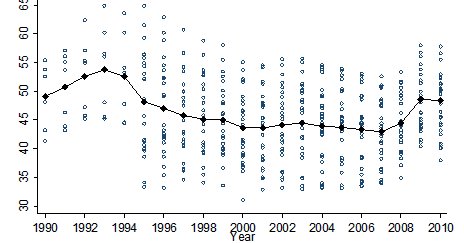It might seem stupid to keep thinking about this today, when while Spain or Italy dismantle social programs, countries like Poland or Estonia are building their own ones. However, science is obstinate and the debate on convergence is still alive. The most recent studies (1) find not only that states are converging in social policy, but also that EU membership is an important factor of the strength of this phenomenon.
But to what extent are social budgets becoming more similar?
The answer data (2) gives to this is simple: not to a great one, certainly. We observe persistent differences among groups of countries, but with a certain tendency to reduce gaps between them. To see this more graphically, the image below shows the level of social expenditure by year and country. Each column of points is a year, and every point, a country. This is useful to appreciate the moments of greater dispersion and the tendency to reduce it from its peak in the mid-90s (3). As one could imagine, the data shows how Nordic countries have a systematically higher expenditure than other groups, and how the UK remains the lowest.
Did the EU contribute?
Until late 2011, the EU had delivered a total of 1167 acts on social policy. However, when considered in context, the regulatory effort of the EU is small in this area compared with the total amount of legislation.
One way to see if the increase of social policy regulation had any effect on the similarity of national social budgets is to measure their statistical association. Results here are strikingly clear: there is virtually no relationship between the amount of regulation on social policy and the intensity of convergence, but this cannot be interpreted as EU initiatives not having affected at all national social policies.
Intergovernmental agreements of economic governance are more important for social policy convergence than the number of directives and regulations about it. In other words, having the framework of the EU might be important because of the opportunity it provides for sharing policy ideas, and not only for the directives it produces. Whether we like it or not, we must admit that this form of contribution means that the EU is, regarding social policy, at a very primary state.
Budgets are still very different, but have been getting more similar not because of harmonizing legislation, but rather as a functional consequence of economic integration.
With the completion of the single market and the creation of the Monetary Union, the economic interdependencies among member states reached a level at which internal social policy contaminates the global competitiveness of the market . Over the last four years we have seen how persistent public deficits affected monetary stability and market attractiveness, and because social policy is normally the biggest component of public spending, its composition has become a European-wide issue. We need (urgently) to treat it as such.
Why cannot we converge (yet) on social policy?
The welfare states have been through the last 50 years nation-building projects in many countries, institutions that created strong bounds of solidarity among people. If we are to share these policies at the European level, we must also share some kind of solidarity beyond the national boarders of social programs. Without certain homogeneity in legitimacy and practical sustainability (cultural practices), the implementation of a European policy of social expenditure is unthinkable.
Survey data reveals that attitudes that could be thought to help in these processes, such as how trustful people are of their fellow citizens, have not converged at all across European societies. EU social policy finds itself handicapped between the development required by spillovers from economic processes and the social conditions tightened into national spaces.
In the short term, there are not a lot of alternatives to create the conditions for increasing the size of social Europe. Fundamentally because the inter-personal space of solidarity that it requires has not yet penetrate the thick skin of nationhood. In the long term, the probable future fiscal union could lead to major negotiations of national budgets, which would mean a sudden Europeanization of social expenditure. So far, it is too difficult to imagine how public opinions would accept it.

Follow the comments: |
|
